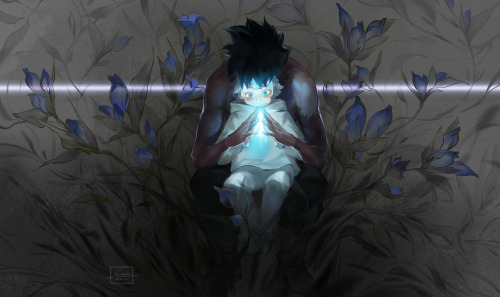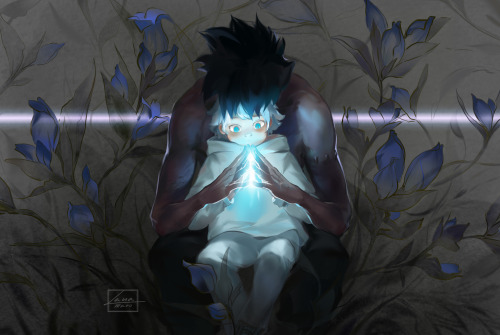Iruma Eating A Cupcake . Courtesy Of @fanfiction-artist-prototype

iruma eating a cupcake . courtesy of @fanfiction-artist-prototype
More Posts from Tessrry and Others
so you’d rather the mla stick around as a sore thumb and the lov to stay broke and weak than for both to join forces, creating a definitive resolution to the my villain aca arc and consolidated threat for the heros? are you so against it being settled by a fight that you’d rather it be dragged out?
my feelings about the resolution to the mla arc are honestly mostly negative. i don’t feel like it makes sense for either side join forces (unless they plan on backstabbing each other, or unless hori is deliberately introducing a regression for the lov, which are all possibilities but lets take the resolution at face-value for the sake of this discussion). it’s been laid out since overhaul’s arc that the lov are tight-knit and value one another as comrades. even if you excise tomura out of the equation for his questionable/nebulous attitude towards relationships, twice and toga are very explicitly characterized as protective, and vengeful toward people who hurt one of “their own.” but at the end of the mla arc, they’re inducted into this organization which not only tortured and held giran for weeks, but also has no second thoughts about using their own members as canon fodder—which is, again, almost exactly what the shie hassaikai were like! if hori were going to have them collab with a shie hassaikai-ish organization later on, then why even bother drawing a comparison between shigaraki & the lov and overhaul & the yakuza?
on the mla’s side, their reasons for capitulating (at least as internally narrated by redestro during his defeat) are completely bs. the mla’s vision wasn’t just a nebulous conception of “freedom”; they had a specific vision of what that freedom looked like. they were a group who planned to rebel for the legalization of indiscriminate quirk use (defined as “freedom”), which is a specific, targeted, and limited goal; no amount of marveling at decay indicates that the logical progression is to embrace shigaraki’s desire for indiscriminate destruction. for a group of people who have largely benefited from the overall structure of society (they’re fucking ceos with some top heroes on call and shit ffs), it makes very little sense for them to buy into the utter unpredictability of shigaraki’s agenda just because he put on a very compelling live performance piece by curbstomping redestro. having two different visions of the future really isn’t a narrative conflict that should be solved by a physical fight, or at least not a straightforward a fight as this one.
like, i know it’s the Way of Shounen to have most things settled by a fight as an easy shorthand for interpersonal development. maybe the L is on me for feeling like the conflict could’ve been handled more satisfactorily & for ideology to actually interact in meaningful ways (even if it leads to one side renouncing theirs) rather than for the resolution to be a metaphorical dick slinging contest. sure, it’s true that it does all those things you said (consolidate a base for the villains, become a real threat, etc. etc.). it’s true that it moves things along, and i’m not against that. BUT i think that making these two particular villain groups ally with each other makes both of their characterizations worse: the lov bcs they’re turning back on earlier characterization from the overhaul arc, and the mla bcs it feels like they can’t fucking stick to a conviction. this wouldn’t be such a big problem if the mla were written differently from the start or, yes, if hori took more time to tell me why the fuck these guys aren’t still trying to kill each other, because tbh nothing about these two groups tell me that joining together is the logical conclusion.
i know you've touched on this subject before but it really pains me to hear how people voice their want for touya to die instead of being on life support despite the fact that he, himself, still wanted to live. "there are still arguments I want to have, and things I still want to say," after all.
i think people misunderstand a lot of touya's feeling about taking his own life at the end of it all. from what i took about his character, as soon as he reclaimed is name again, he regressed back into how he was emotionally as a child, and it only got worse from that point.
a damaged child, especially a neglected one, will always hurt themselves and care little when they've been shown no care. so how do they get that care? hurting themselves, and if necessary, ending their life. but he doesn't need to do that anymore.
he wanted to live, and though his circumstances are saddening (or well was, let's hope he can finally do things considering there was no confirmation), it's a good thing he showed some kind of regret about the fate he nearly had, and expressed a desire to still continue.
I think this is fully on how Horikoshi depicted the situation with needlessly cruel horror that feels really unnecessary.
If Ch 426 put more care into depicting Touya:
1. Not being in pain
2. Getting relief from his family coming to see him
3. Getting affirmation that he’s loved and always was
4. Showed that people were in fact grateful for being saved
People wouldn’t feel like Touya would have been better off dying. Think in comparison how nobody says that Spinner or Overhaul would have been better off being dead and it becomes painfully obvious how Horikoshi undermines his own narrative with the circumstances he set up, which feel like needless horror.
I fundamentally understand what he’s trying to portray, but I think his art choices are at odds with his narrative goal (if that is to depict a peaceful death for Touya as a fix-it for his violent death on Sekoto peak).
Even if he wanted to depict Touya’s hopeless, miserable state,he could have shown the chapter in parallel from an internal headspace where we can see child Touya getting emotional relief -sort of a continuation of the Ch 388 image.
![13 Yrs. Touya Under Care Of Ujiko [theory]](https://64.media.tumblr.com/90d86051dbe1b212545e462612ac2176/d26f606f228bc028-27/s500x750/2a7057b2ddeff699df96fe8993315f0136cd6b25.jpg)
13 yrs. Touya under care of Ujiko [theory]
I really like hori Noumu design it a perfectly mixture of hideous and cute
————–
I don’t think Ujiko is a good person, he really twisted and a mad scientist type. but I think he have soft spot for all his creature [aka. noumu] like it his child/possession.
————–
I wonder if Noumu is cuddlable? or even comfortable to cuddle or not [but it made out of flesh so maybe it smooth for texture?]
so the heteromorph discrimination plotline had seemed to explode into the manga with Chapter 370 when the story switched battles to the site of Central Hospital where Spinner is leading disgruntled heteromorphs to retrieve Kurogiri;
though the story did hint it would be addressed since Chapter 310 when Ordinary Woman (big heteromorph gal) was attacked by civilians because they didn’t like they was she looked;
and the first time we got confirmation that such prejudice exists in the HeroAca world was Chapter 220, when the League massacres a bunch of CRC bigots and Spinner’s backstory was revealed (that he suffered through such discrimination all his life and was finally motivated to do something about suffocating in the pervasive heteromorphobic hostile environment - among other things - when he saw Stain on TV);
but I think the story did well to hint at this issue throughout the manga in the background. I would say the first ever hint we get is all the way in Chapter 5, when Deku arrived on his first day at UA and noticed his classroom door was huge:

Has to be accessible to everyone, he says, and that greatly stood out to me.
Because, see, heteromorphic discrimination isn't just judging people by their looks - which is often the go-to discrimination allegory fiction uses, usually based on the irl social construction of race and the issue of racism; nor is it being prejudiced against people with superpowers, because this is a world where 80% of the population have a superpower and having a quirk is accepted (in fact, not having a quirk is considered strange and unusual); rather, heteromorphic discrimination in the HeroAca World takes elements from, yeah, racism, but also ableism.
In this world, quirks gives people a wide, wide diversity of appearances - different body sizes, shapes, anatomy, functions. And different people have different needs. Someone with a quirk that gives them a tail would need a hole cut into their pants so their tail can go through and they can actually wear the pants. Someone who's really, really tall - whether because they have a giraffe neck quirk or just a big body size quirk - would need buildings to have doors that fit them.
How is this ableism? Well, one big issue in disability rights is accommodation. As wikipedia puts it:
Disability discrimination, which treats non-disabled individuals as the standard of 'normal living', results in public and private places and services, educational settings, and social services that are built to serve 'standard' people, thereby excluding those with various disabilities.
A wheelchair user can't go up steps. An event that communicates only through talking would not allow deaf people to participate fully. A world where only abled-bodied people can travel, can communicate, can exist is one that excludes disabled people, preventing them from being full members of their community, and this is the definition of discrimination.
Heteromorphs and people with body-altering quirks in HeroAca world aren't disabled. However, they do have atypical bodies and sometimes unique requirements to live regularly as anyone else. If this impedes their daily functioning, then they would have what can be classified as an impairment. If that impairment causes them to face a barrier that stops them from interacting with other people and the larger outside world, then it can be classified as a disability.
This fluid nature of what can be classified as an impairment or disability means depending on the situation, an able-bodied person can technically experience barriers similar to what disabled people experience.
This is the social model of disability. That
the origins of disability [are] the mental attitudes and physical structures of society, rather than a medical condition faced by an individual...
the most significant barrier for individuals with disabilities is not the disability itself; rather the most significant barrier is the environment in which a person with a disability must interact. Society disables people, through designing everything to meet the needs of the majority of people who are not disabled.
So, if someone with lots of limbs and appendages can't find clothes that fit them, they cannot go outside without violating public decency laws. If someone who's really big can't fit through a standard door and enter buildings, they're effectively blocked from going to school, public transportation, work, etc. This is best illustrated and pointed out explicitly by Kamayan, a character with a giant mantis quirk:
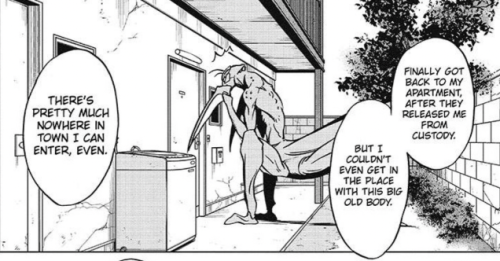
He's from Vigilantes, but the problem he faces is something Horikoshi has already considered, hence the panel from Chapter 5 above.
In fact, Mt. Lady also faced this problem in Chapter 1, when she is unable to fight a Villain and save Bakugou because she's unable to enter a street:

Luckily for Mt. Lady, her quirk allows her to shrink to normal size. But imagine if she was just big like that always. She would be unable to go anywhere. There probably is a quirk out there that is just that: makes someone big, all the time.
These quirks are individual issues. They can technically be viewed as a personal problem, and if the person is unhappy with their situation, then it's up to them to get it 'fixed'. However, that sort of defeats the purpose of having a quirk and accepting that this world is one where everyone has a quirk and should be allowed to exist as they are. Plus, heteromorphs are a significant portion of society.
Rather than telling people whose quirks makes them super tall to stay home - and this would be exclusion and discrimination - why not just build bigger doors and buildings? UA does this, and they're in the right. However, as Kamayan and Mt. Lady (Big Mode) shows, there are still places that don't do this. As Kamayan notes:
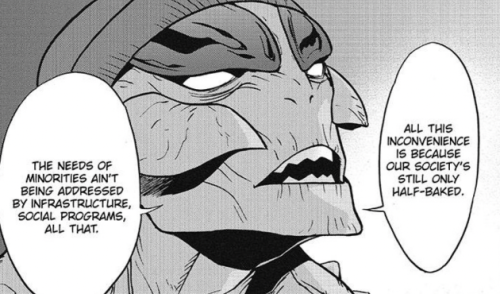
All the way in the beginning of the story in Chapter 5, the issue of accessibility in regards to atypical bodies. Because heteromorphs are people who have atypical bodies, they are most likely to face issues of accommodations. If they do, and they are unable to live well under the current status quo, then yeah, what they go through would be discrimination. Most heteromorphs we see in the series seem to be getting by okay, but it's easy to imagine that they can and have faced barriers because of their body-altering quirks:
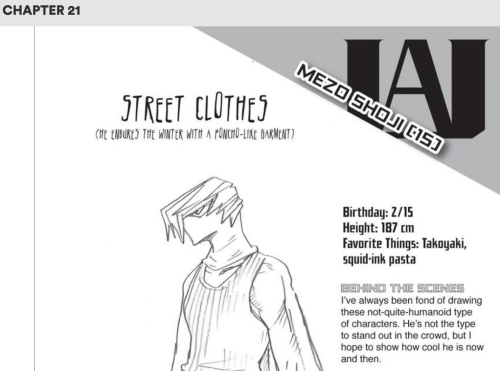
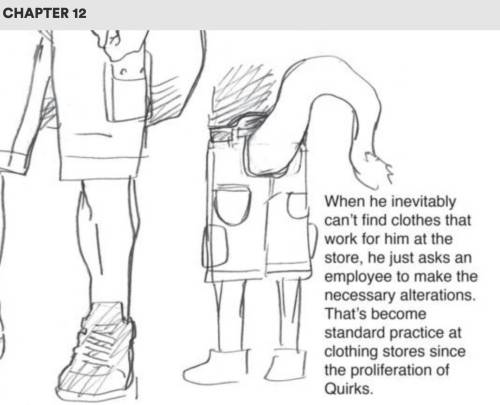
Ojiro requires his clothes to be altered. Shoji is apparently unable to wear a coat, and needs a poncho-like garment in cold weather. These aren't big issues because as Ojiro's profile states: "altering clothing have become standard practice at clothing stores", but a store can also easily just refuse to do so. A store can refuse to serve heteromorph customers because they find tailoring annoying. They don't need to hate and insult heteromorphs for it to be discrimination; they just have to not care.
(does it also cause more money, to ask for alterations? Is it something that gives heteromorphs financial issues, if they need different enough accommodations?)
However, often when a minority bring up an issue they face to the majority and suggest addressing it, the apathy can quickly change to annoyance. Actually, any kind of annoyance can mutate into outright disdain and prejudice. In a span of a second, the majority can go from indifferent, maybe even mildly supportive (as long as it doesn't inconvenience them), to hostility with a desire to remind the minority they're different, they're unwanted, they are not quite human, not like the majority.
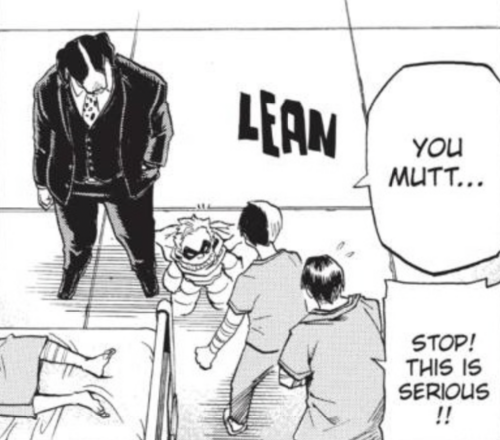
Chapter 56 shows this attitude exactly. Tsuragamae Kenji is the Chief of Police, but when he suggested something that someone found disagreeable, he is quickly disrespected and called a 'mutt' (in the original Japanese, 「この犬…」 "this dog...").
This would probably be considered a microaggression, calling someone with an animal-heteromorphic-quirk an animal. The first instance of microaggression in the manga is actually in Chapter 6, in which Shoji is asked if he's an 'gorilla' or 'octopus'. This was actually addressed as such in Chapter 371! The next instance is Chapter 21, in which Officer Sansa is subjected to the stereotype of... not being a police dog, I guess?)

They're just microaggression, words that come and go, perhaps, but the attitudes that give microaggression space to exist stem from the same place as anti-acceptance on the level of denying accessibility.
The examples of anti-acceptance so far talked about in this post is relatively minor, and actually just hinted at. However, in Chapter 57, we are given a rather extreme example of body modification in order to fit the 'norm'. In Chapter 57, we meet Daikaku Miyagi, whose appearance is very notable in that one of his horns look like it was cut off. Turns out, that's exactly what happened.

Daikaku Miyagi was praised this deed, as it was considered being considerate of his TV audiences . It's true this is a personal decision, and he can do whatever he feels is best for him, but one has to wonder about why instead of news stations accommodating easily editable visual presentations, the fix is chopping off a healthy body part.
The extra notes that describe his situation calls it 'rejection of Quirks'. In the same chapter, Gran Torino calls the current era "an age of suppression". Rejection, suppression - we are shown that this is a quirk society that hasn't actually embraced and accommodated quirks. Rather, quirk use is banned and a norm is defined that everyone is encouraged to follow. That seems simple enough when your quirk is an emitter that you can just not emit from your body.
So what happens when your quirk *is* your body? Which brings up questions of how heteromorphs live in such a society. Is using an extra appendage quirk use? If you have a full-body heteromorphic quirk and you get in a tussle in the heat of the moment, is that regular assault or is quirk use added onto the charges? People with quirks that gives them a 'scary' heteromorphic appearance - is that why it looks like these kind of people dominate the role of villains? The first Villain the reader ever sees in the manga is a heteromorph (the purse-snatcher). As is the second (Sludge Villain). Most of the crowd of Villains that Shigaraki brings to invade UA seems to be heteromorphs, actually.
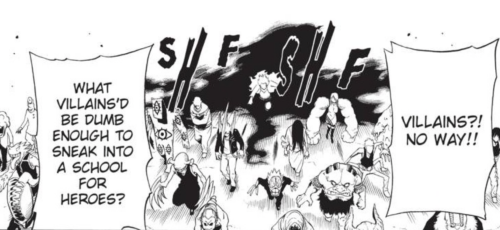
One or two heteromorphic villains is just two randos running around. When it becomes a pattern that most Villains in HeroAca seem to be heteromorphs, the 'why' needs to be asked and a cause identified. Is it because they feel suppressed, as Gran Torino says? Rejected because of their appearance and quirks? If being a heteromorph means a higher chance of receiving microaggressions and being excluded from society - pushed to the margins, and left to do questionable things to survive - and a high chances of falling into Villainy, there is probably an societal problem.
All this is in the first 100 chapters. Similar to the development of Villains and the causes of that villany, the issue that heteromorphs face isn't focused on - they're scary looking villains, the issues brought up about Hero Society is vaguely implied. Horikoshi himself said he didn't expand on the Villains much at first on purpose because he wanted them unknowable and scary.
Of course, I would say Heteromorph Discrimination is a subsection within a larger category of Quirk Discrimination. Or maybe in-universe, this can be a type of 'intersectionality'. Toga's backstory in Chapter 227 is the failure of quirk counseling, but as we see in Chapter 370, about 150 chapters after Chapter 227, quirk counseling has also failed heteromorphs because it's 'one size fits all' simply was not equip to deal with the inherent variability of heteromorphic quirks. Meanwhile, the concept of 'kegare' - impurity - that's first introduced by the CRC in Chapter 220 and expanded on in Shouji's backstory recently in Chatper 371, being a base for why heteromorphs are hated in the countryside - that they defile the land and taint others - is also something that can apply to quirks like Shigaraki's and Toga's: decay/death and blood are things that would be considered 'impure' and thus avoided.
In anycase, throughout the manga, we're give subtle, background examples of issues heteromorphs face, like accessibility, dehumanization, making up a higher proportions of villains. Altogether, it pointed to plain discrimination, of which a lifetime of experiencing can wear a person hollow. To quote Shigaraki/Tenko, "it built up...little by little, over time". And then it exploded, but the fuse had been slowly burning for quite a while.
-
 tessrry reblogged this · 2 weeks ago
tessrry reblogged this · 2 weeks ago -
 wannabeavocaloidmystery liked this · 7 months ago
wannabeavocaloidmystery liked this · 7 months ago -
 slagathorius-maximus liked this · 7 months ago
slagathorius-maximus liked this · 7 months ago -
 sunray28 liked this · 7 months ago
sunray28 liked this · 7 months ago -
 lurkerdum liked this · 7 months ago
lurkerdum liked this · 7 months ago -
 hashibag liked this · 7 months ago
hashibag liked this · 7 months ago -
 fanfiction-artist-prototype reblogged this · 7 months ago
fanfiction-artist-prototype reblogged this · 7 months ago -
 guesst reblogged this · 7 months ago
guesst reblogged this · 7 months ago
